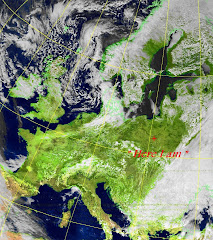 |
| AD9850 DDS module on breakout board with interface dongle |
 |
| CH1 sine wave output, CH2 comparator output +DUT 25% |
This post is about using those cheap DDS, ( Direct Digital Synthesizer ), modules based on the AD9850 or AD9851 DDS chips, and found on auction sites for only a few dollars. I have been programming and using them for several years, going back as far as August 2013 ( see post 27/08/2013 ). I am now using the interface dongle, ( USB-SPI v1.00 ), and software from www.spectecs.com which makes the modules extremely quick and easy to use; the tuning word is created and uploaded to the DDS over USB with just a few mouse clicks.
The modules are ideal as a signal source for testing amplifiers etc or embedded in projects which is what I have done recently with the phasing exciter ( 02/11/2017 ) using an AD9851 DDS module on that occasion.
I made a simple jig, ( break-out board ), for speed and convenience when connecting the module for use as a stand-alone signal source. The SPI and output connectors are extended out to pin-strip headers. I also provided LEDs for testing the two GPOs from the dongle.
The module has two sine wave outputs, ( OUT1 & OUT2 ), two square wave outputs ( VO_P & VO_N ). Sine output OUT2 is present on the disconnected black jumper. Referring to the top picture, I've set the jumpers as follows:
J1 green, connected = serial data upload, ( disconnected = parallel data upload ).
J2 blue, connected = enable square wave output, ( disconnected = no square wave output ).
J3 yellow, connected = digital to analogue converter ( DAC ) full scale current set internally, ( disconnected = DAC current set externally ).
I uploaded a tuning word ( hex 010624DD ) for the DDS to generate an output signal at 500KHz. The duty cycle of the square wave is adjusted using the trim-pot next to J2. I found the range of adjustment to be about 12%-87%. The lower picture shows the signal on OUT1 ( 1V peak to peak ), and VO_P ( 5V peak to peak ), which I adjusted for 25% duty cycle.
Although the top picture features the AD9850 DDS module, the AD9851
module is identical in appearance apart from the chip type of course.








